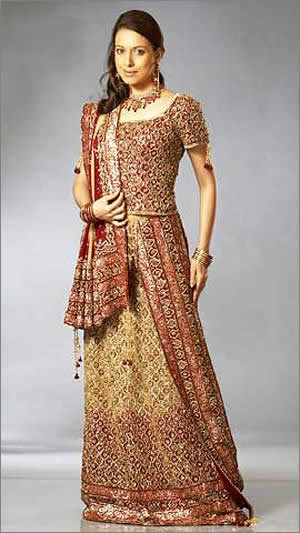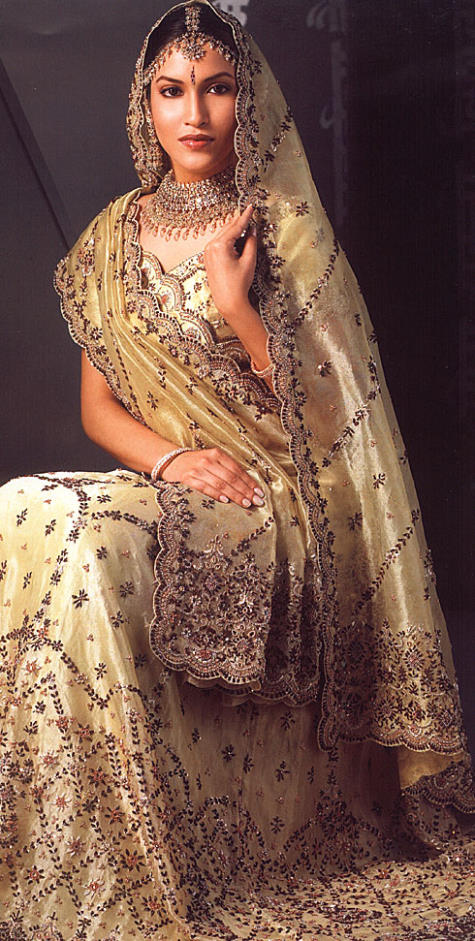Lehenga For Wedding Biography
source link :- google.com.pkLehenga For Wedding
Bridal lehenga is the traditional Indian wedding dress. Most of the Indian wedding bridal lehengas are heavily embroidered but the density of embroidery depends upon your choice. These Indian wedding bridal lehengas come in all sort of fabrics with silk still ruling the market. Small beads, kundans, stones, jari, resham embroidery etc are used extensively on bridal lehenga for embellishment. If you talk about colors then red dominates over the others although some brides experiment with off white, orange, magenta, blue and pink colors as well. While selecting any bridal wedding lehenga give preference to your choice as after all it is your wedding. View photo gallery on different bridal lehenga, Indian wedding bridal dresses, red Indian wedding lehenga and heavy embroidered Indian wedding dresses for bride.
Lehenga For Wedding or Ghagra choli, which is also known as Lehenga choli, is the traditional clothing of women in Rajasthan Gujarat, Madhya Pradesh, Uttar Pradesh, Bihar, Haryana, Himachal Pradesh and Uttarakhand. It was the traditional attire of women in Punjab before the advent of the salwar kameez. Chaniya choli is another term commonly used to refer it.It is a combination outfit of a Lehenga For Wedding tight Choli and a Dupatta. A choli ravike in South India Telugu: Kannada: is a midriff-baring blouse shell garment in the Indian sari costume worn in India, Pakistan, Sri Lanka, Bangladesh, and other countries where the sari is worn. The Lehenga For Wedding is cut to fit tightly to the body and has short sleeves and a low neck. The choli is usually cropped, allowing exposure of the navel; the cropped design is particularly well-suited for wear in the hot South Asian summers. Cut-out backs and front-opening buttons are some of the features of contemporary designs. Lehenga For Wedding.
Illustration of different regional variations of Ghagra choli worn by women in India.
Lehenga or Ghagra is a form of skirt which is long, embroidered and pleated. It is worn as the bottom portion of a Gagra choli. It is secured at the waist and leaves the lower back and midriff bare. The ancient version of skirt or Ghagri evolved from Bhairnivasani, which in turn evolved from the Antariya when stitched on one side became tabular and was worn gathered together at the waist, and held by a girdle. This was one of the earliest forms of a clumsily stitched skirt. It was worn using drawstring or nada. The ghagri was a narrow skirt six feet long the same length as original antariya. This style can still be seen worn by Jain nuns in India. The Lehenga For Wedding are made of a number of fabrics such as Silk, Cotton, Khadi, Georgette, Crape, Net, Satin, Brocade and Chiffon. Even though designers have successfully used the various kinds of fabrics for making the lehenga, silk is still the most preferred fabric.
Decorative stitching.Apart from the fabric, decorative stitching patterns also play a role. Lehengas come with a wide variety of decoration and embroidery work like Gota, Phulkari, Shisha, Chikankari, Zari, Zardozi, Nakshi, Kundan, etc. For festivals like Navratri, the ethnic Shisha embroidery is popular with a bit of patchwork. For formal wear and weddings, the embroidery is heavier in pearls, silk, sequins and zari.
Kutch embroidery is an evolving expression of the craft and textile traditions of the Rabaris, a nomadic tribe in Gujarat.Kutch work is unique in the sense that a net is woven on a cloth using thread.The net is then filled in using the same thread by intricate interlocking stitches. Lehenga For Wedding.
The patterns are usually built around geometric shapes.This embroidery follows its own traditional design logic and juxtaposition of colours and motifs. The Rohanas tribals of Kutch specialise in skirt work. The Sodhas use a geometric style for their embroidery. The Garacia Jats are experts in tiny embroidery on the yoke, which intermingles with red, orange, blue and green threads. The Dhanetah Jats love embroidering broad pear-shaped mirrors using orange, black, yellow and red in chain stitch.
Significance in rite of passage. In South India coming of age ceremony or rites of passage (Langa Voni Telugu: Pattu Pavadai Tamil: Is celebrated when a girl reaches puberty. She wears Langa Voni given by her maternal grandparents, which is worn during the first part of the ceremony and then she is gifted her first Sari by her paternal grandparents, which she wears during the second half of the ceremony. This marks her transition into womanhood.






















No comments:
Post a Comment